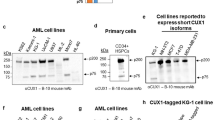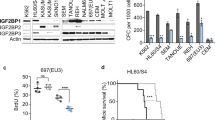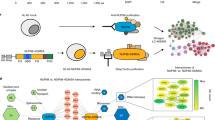Abstract
SH3 and SAM domains are protein interaction motifs that are predominantly seen in signaling molecules, adaptors, and scaffold proteins. We have identified a novel family of putative adaptor genes that includes HACS1. HACS1 encodes a 441 amino acid protein that is differentially expressed in hematopoietic cells and has restricted expression in human tissues. Its SH3 domain is most similar to the same motif in Crk and its SAM domain shares homology with a family of uncharacterized putative scaffold and adaptor proteins. HACS1 maps to human chromosome 21q11.2 in a region that is frequently disrupted by translocation events in hematopoietic malignancies. Polyclonal antibodies against HACS1 recognized a 49.5 kDa protein whose mRNA is expressed in human immune tissues, bone marrow, heart, lung, placenta and brain. Cell lines and primary cells from acute myeloid leukemias and multiple myeloma patients express HACS1. Immunostaining and cellular fractionation studies localized the HACS1 protein predominantly to the cytoplasm.
This is a preview of subscription content, access via your institution
Access options
Subscribe to this journal
Receive 50 print issues and online access
$259.00 per year
only $5.18 per issue
Buy this article
- Purchase on Springer Link
- Instant access to full article PDF
Prices may be subject to local taxes which are calculated during checkout




Similar content being viewed by others
References
Andrews NC, Faller DV . 1991 Nucleic Acids Res. 19: 2499
Arrowsmith CH . 1999 Cell Death Differ. 6: 1169–1173
Claudio JO, Liew CC, Dempsey AA, Cukerman E, Stewart AK, Na E, Atkins HL, Iscove NN, Hawley RG . 1998 Genomics 50: 44–52
Golub TR, Baker GF, Lovett M, Gilliland DG . 1994 Cell 77: 307–316
Golub TR, Barker GF, Bohlander SK, Hiebert SW, Ward DC, Ward P, Morgan E, Raimondi SC, Rowley JD, Gilliland DG . 1995 Proc. Natl. Acad. Sci. USA 92: 4917–4921
Golub TR, Goga A, Barker GF, Afar DE, McLaughlin J, Bohlander SK, Rowley JD, Witte ON, Gilliland DG . 1996 Mol. Cell. Biol. 16: 4107–4116
Kyba M, Brock H . 1998 Dev. Genet. 22: 74–84
Lacronique V, Boureux A, Valle VD, Poirel H, Quang CT, Mauchauffe M, Berthou C, Lessard M, Berger R, Ghysdael J, Bernard OA . 1997 Science 278: 1309–1312
Mitelman F, Mertens F, Johansson B . 1997 Nat. Genet. 15: 417–474
Pawson T . 1995 Nature 373: 573–580
Rhodes J, York RD, Tara D, Tajinda K, Druker BJ . 2000 Exp. Hematol. 28: 305–310
Serra-Pages C, Kedersha N, Fazikas L, Medley Q, Debant A, Streuli M . 1995 EMBO J. 14: 2827–2838
Sheng M, Kim E . 2000 J. Cell Sci. 113: 1851–1856
Shi CS, Tuscano J, Kehrl JH . 2000 Blood 95: 776–782
Stapleton D, Balan I, Pawson T, Sicheri F . 1999 Nature Struct. Biol. 6: 44–49
Stein E, Cerretti DP, Daniel TO . 1996 J. Biol. Chem. 271: 23588–23593
Tu H, Barr M, Dong D, Wigler M . 1997 Mol. Cell. Biol. 17: 5876–5887
Acknowledgements
We thank E Wei for her technical assistance. JO Claudio is a recipient of Career Development Fellowship from the Canadian Blood Services. SJ Benn is a fellow of the Natural Science and Engineering Research Council of Canada. AK Stewart is supported with funds from the National Cancer Institute of Canada, the Canadian Institutes of Health Research, The ABC group and The Myeloma Research Foundation.
Author information
Authors and Affiliations
Corresponding author
Rights and permissions
About this article
Cite this article
Claudio, J., Zhu, Y., Benn, S. et al. HACS1 encodes a novel SH3-SAM adaptor protein differentially expressed in normal and malignant hematopoietic cells. Oncogene 20, 5373–5377 (2001). https://doi.org/10.1038/sj.onc.1204698
Received:
Revised:
Accepted:
Published:
Issue Date:
DOI: https://doi.org/10.1038/sj.onc.1204698
Keywords
This article is cited by
-
SASH1 is a prognostic indicator and potential therapeutic target in non-small cell lung cancer
Scientific Reports (2020)
-
Deconvolution of single-cell multi-omics layers reveals regulatory heterogeneity
Nature Communications (2019)
-
The Evolution and Expression Pattern of Human Overlapping lncRNA and Protein-coding Gene Pairs
Scientific Reports (2017)
-
Activation and cleavage of SASH1 by caspase-3 mediates an apoptotic response
Cell Death & Disease (2016)
-
Identification of novel pathogenic copy number aberrations in multiple myeloma: the Malaysian context
Molecular Cytogenetics (2014)



